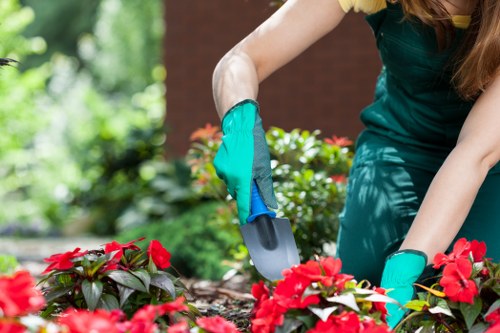Driveway Algae Removal in Sands End: Keep Your Home Spotless

Living in Sands End comes with its unique charm, nestled by the River Thames and surrounded by beautiful residences. However, one common issue homeowners face is the growth of algae on driveways. Algae not only tarnishes the appearance of your property but can also make your driveway slippery and hazardous.
Understanding why algae thrives in Sands End is the first step toward effective removal and prevention. The damp climate, combined with shade from nearby trees and structures, creates the perfect environment for algae to flourish.
Removing algae from your driveway doesn’t have to be a daunting task. With the right approach and tools, you can restore your driveway’s beauty and safety. This article explores the best methods for algae removal in Sands End, ensuring your home remains pristine.

Understanding Algae on Driveways
Algae are simple plants that thrive in moist environments. They spread quickly on surfaces like concrete, asphalt, and paving stones, especially in shaded areas. While algae themselves aren't harmful, their presence can lead to slippery surfaces and damage to your driveway over time.
In Sands End, the combination of rain, shade, and organic matter from trees provides an ideal setting for algae growth. If left untreated, algae can deteriorate the surface of your driveway, making it look unsightly.
Recognizing the signs of algae is crucial. Look for slimy, greenish patches, especially in damp or shaded areas. Early detection can make removal easier and prevent extensive damage.
- Green or black slimy patches
- Slippery surfaces when wet
- Discoloration of driveway materials

Causes of Algae Growth in Sands End Driveways
Several factors contribute to the growth of algae on driveways in Sands End. Understanding these causes can help in effective removal and prevention.
Moisture and Shade
High moisture levels combined with shaded areas create a perfect breeding ground for algae. Trees and buildings often cast shadows, reducing sunlight and keeping surfaces damp for longer periods.
Organic Matter
Leaves, twigs, and other organic debris can accumulate around your driveway, providing nutrients for algae to thrive.
Poor Drainage
Areas with poor drainage retain water, increasing the likelihood of algae growth. Standing water can exacerbate the problem, making it harder to keep your driveway dry.
- Frequent rainfalls
- Blocked gutters and drains
- Lack of sunlight exposure

Importance of Removing Algae
Removing algae from your driveway is essential for several reasons:
- Safety: Algae can make surfaces slippery, posing a risk of falls and injuries.
- Property Value: A clean driveway enhances your home's curb appeal and value.
- Durability: Algae can deteriorate driveway materials, leading to costly repairs or replacements.
Regular maintenance and timely removal of algae can save you from bigger problems down the road.
Protecting Your Investment
Your driveway is a significant investment. Keeping it free from algae ensures it remains functional and attractive for years to come.

Methods for Driveway Algae Removal
There are various methods available for removing algae from driveways in Sands End. The choice depends on the severity of the growth, the type of driveway, and your preference for eco-friendly solutions.
Pressure Washing
Pressure washing is a popular method for algae removal. It uses high-pressure water to blast away algae and other debris from driveway surfaces.
- Effective for large areas
- Quick and efficient
- May require professional assistance
Chemical Treatments
Chemical algae removers can be applied to break down and eliminate algae. These treatments are often designed to target specific types of algae without harming the driveway material.
- Effective for stubborn algae
- Requires careful application
- Ensure products are eco-friendly

Eco-friendly Solutions
For those concerned about the environment, eco-friendly algae removal solutions are available. These methods use natural ingredients to clean driveways without harmful chemicals.
- Vinegar and baking soda mixtures
- Hydrogen peroxide treatments
- Biodegradable cleaning agents
Eco-friendly solutions are not only safer for your driveway but also for the surrounding flora and fauna in Sands End.
Home Remedies
Simple home remedies can also be effective in removing algae. Regular cleaning and maintenance using household items can keep your driveway algae-free.
- Scrubbing with a stiff brush
- Applying a mixture of bleach and water
- Using steam cleaning techniques
These methods are budget-friendly and can be performed without professional help.

Preventing Future Algae Growth
Prevention is always better than cure. Taking proactive steps can help prevent algae from returning to your driveway in Sands End.
Improve Drainage
Ensure proper drainage around your driveway to reduce moisture accumulation. Fixing leaks and clearing blocked gutters can make a significant difference.
Increase Sunlight Exposure
Trim overhanging branches and remove obstructions that block sunlight. More sunlight can help keep your driveway dry and less hospitable to algae.
Regular Cleaning
Maintain a regular cleaning schedule to prevent algae from establishing itself. Sweep away debris and wash your driveway periodically.
- Weekly sweeping
- Monthly washing
- Seasonal maintenance

Choosing the Right Service in Sands End
Selecting the appropriate algae removal service is crucial for achieving the best results. Here’s what to consider when choosing a service provider in Sands End.
Local Experts
Opt for local experts who understand the specific conditions of Sands End. They are more likely to provide tailored solutions that address the unique challenges of your area.
What to Look For
When selecting a driveway algae removal service, consider the following:
- Experience and expertise
- Use of eco-friendly products
- Customer reviews and reputation
- Competitive pricing
- Guarantees and warranties
Taking the time to research and choose the right service provider can ensure effective and lasting algae removal from your driveway.

Local Relevance: Nearby Areas to Sands End
Driveway algae can be a common issue across various neighborhoods near Sands End. Understanding the proximity and specific features of these areas can help tailor your algae removal efforts effectively.
1. Hammersmith
Located just north of Sands End, Hammersmith offers a mix of residential and commercial areas. Its proximity ensures quick service and easy access for algae removal experts.
2. Fulham
Fulham is known for its elegant homes and green spaces. Driveways here often require meticulous care to maintain their aesthetic appeal.
3. Grove Park
Grove Park boasts beautiful gardens and tree-lined streets. These features, while attractive, can contribute to algae growth on driveways due to increased shade.
4. Ravenscourt Park
Adjacent to Sands End, Ravenscourt Park combines recreational spaces with residential driveways. The lush greenery provides ample shade, promoting algae development.
5. West Kensington
West Kensington is a vibrant area with a mix of old and new properties. The diversity of driveway materials here may require specialized algae removal techniques.
6. Barons Court
Barons Court features a blend of Victorian and modern homes. Its driveways are often expansive, making regular maintenance essential to prevent algae buildup.
7. Chiswick
Chiswick is renowned for its picturesque canals and riverside properties. Driveways here can be particularly prone to algae due to the damp environment.
8. Kensington
Kensington is an upscale area with grand homes. Maintaining driveways free from algae is crucial to preserve the luxury appeal of these properties.
9. Putney
Putney offers a mix of suburban and urban living. Its driveways often face challenges related to moisture from nearby water bodies, encouraging algae growth.
10. Shepherd's Bush
Shepherd's Bush is a bustling area with a variety of residences. High foot traffic and nearby greenery contribute to the frequent appearance of algae on driveways.
11. Queen's Park
Queen's Park is celebrated for its vibrant community and lush parks. The abundant shade from trees makes driveways susceptible to algae infestation.
12. Earls Court
Earls Court combines historical charm with modern amenities. Driveways here require regular upkeep to prevent algae from diminishing their charm.
13. South Kensington
South Kensington is home to numerous museums and elegant residences. Maintaining clean driveways is essential to uphold the area's prestigious reputation.
14. Chelsea
Chelsea is synonymous with luxury and sophistication. Algae-free driveways are a must to match the high standards of this upscale neighborhood.
15. Barnes
Barnes offers a serene environment along the Thames. The proximity to water bodies makes driveways here particularly vulnerable to algae growth.

Frequently Asked Questions
1. How often should I clean my driveway to prevent algae growth?
Regular maintenance is key. It's recommended to clean your driveway at least twice a year, preferably in the spring and autumn, to prevent and remove algae buildup.
2. Are chemical treatments safe for the environment?
Many modern chemical treatments are designed to be eco-friendly. However, it's essential to choose products that are biodegradable and safe for plants and pets.
3. Can I use household cleaners for algae removal?
Yes, household cleaners like vinegar, baking soda, and bleach can be effective for algae removal. Ensure proper dilution and application to avoid damaging your driveway.
4. When should I call a professional for algae removal?
If the algae growth is extensive or persistent despite regular cleaning, it's advisable to hire a professional service. Experts can provide more effective and long-lasting solutions.
5. How can I prevent algae from returning to my driveway?
Improving drainage, increasing sunlight exposure, and maintaining a regular cleaning schedule are effective ways to prevent algae from returning to your driveway.


